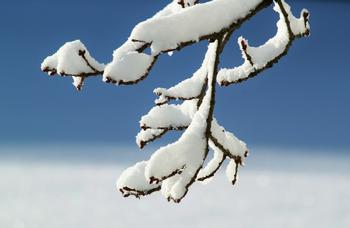Editor's Note: This post was authored by guest blogger Chelsea Hennen, a guest writer for TCIA member Precision Landscape and Tree.
 Harsh winters are trying for trees and shrubs. Cold weather can desiccate foliage, damage bark, and injure or kill branches, flower buds, and roots. Humans and animals contribute to winter tree care issues as well; salting roads and sidewalks damages soil health, and animals tend to feed on tree bark and twigs due to winter food shortages.
Harsh winters are trying for trees and shrubs. Cold weather can desiccate foliage, damage bark, and injure or kill branches, flower buds, and roots. Humans and animals contribute to winter tree care issues as well; salting roads and sidewalks damages soil health, and animals tend to feed on tree bark and twigs due to winter food shortages.
These threats, especially when combined, can severely damage your trees and plants if you aren’t prepared.
Read about common winter tree care issues below to learn about warning signs and treatment recommendations:
Winter Burn
"Winter burn" refers to the browning or bleaching of evergreen foliage during the winter. According to the University of Minnesota Extension, this can happen for four reasons:
- Sun and wind cause trees to lose water throughout the winter. Their frozen roots are unable to replace this lost water. This results in the browning of the plant tissue.
- Sunny days warm the tree's tissue, which in turn initiates cellular activity. When the sun sets, the tree's temperature drops to harmful levels and the activated tissue dies.
- During sunny winter days, chlorophyll in the foliage is destroyed (photo-oxidized). The tree does not re-synthesize when temperatures are below 28 degrees Fahrenheit. This is what causes bleaching.
- Cold temperatures in the fall or late spring can result in injury or death of tree tissue.
Treatment: You can prevent injury by creating a barrier of burlap or similar material on the south, southwest, and windward sides of evergreens. If all sides of the tree are showing signs of injury you can surround the whole tree, but you should leave the top open to allow air and light in.
Frost Heaving
Frost heaving occurs when soil freezes and thaws repeatedly. This pushes small, shallow-rooted plants out of the ground, exposing them to wind desiccation.
Treatment: Mulch can help prevent frost heaving because it acts as an insulator and helps retain moisture. If your plant has already fallen victim to frost heaving, replant it once the soil thaws.
Salt Damage
The salt used on roads and sidewalks can harm your soil, which can threaten your trees and shrubs. The damage can be subtle, at first, as the salt deposits migrate to the stems, buds and roots of the trees. This can cause a severe decline in the tree’s health, as the salt disfigures foliage and stunts tree growth.
Treatment: It is nearly impossible to keep salt out of your yard, but you can minimize the damage by applying salt after you shovel, and by using calcium chloride-based de-icing salts. For more details on this topic, read “De-Icing Salt Can Harm Landscape Plants” on the TCIA Blog.
Winter Drought
Winter drought is a very common issue trees face during the winter. Trees understandably have a difficult time drawing water from frozen ground, and evergreens struggle the most with winter drought.
Treatment: In the fall, mulch and water the area around the tree thoroughly to compensate. To gauge your progress, dig down six inches deep and form a ball with the soil. If the soil stays clumped together, your tree has enough water.
Animals
Mice, rabbits, and other rodents eat tree bark to survive in the winter. This exposes the tree’s base and can cause the tree to die. Deer are also a common winter pest, and are known to feed on tree stems and branches.
Treatment: To ward off smaller critters, surround the tree with metal mesh. You may also use a repellant containing thiram, a common fungicide, to discourage the local wildlife. Either spray the repellant directly on the tree, or dip heavy rags in concentrated repellant and hang them near the tree you want to protect. The latter method is especially effective for warding off deer.
Dead or Broken Branches
Snow and ice can weigh down your branches and cause them to break. To prevent this from happening, check your trees periodically and brush off snow as it accumulates. Brushing may break the trees branches, however, so be careful!
Treatment: If a snow-laden branch is posing a hazard, that’s a different story. Broken or dead branches can fall without warning, especially when burdened with snow and ice. In this case, call a professional arborist to remove the branches safely.
Leave it to the Professionals
A professional arborist can help with all of the common winter tree care issues listed above. Find a qualified arborist in your area.
About the Author
 Chelsea Hennen is an avid writer and researcher of tree care and landscaping. She has written informational articles and guest blog posts for a variety of industries, including legal guidance, home improvement and corporate planning. She is a guest writer for Precision Landscape and Tree, a company that serves the Twin Cities metro area with over 30 years of experience in tree care, timber management, and land removal.
Chelsea Hennen is an avid writer and researcher of tree care and landscaping. She has written informational articles and guest blog posts for a variety of industries, including legal guidance, home improvement and corporate planning. She is a guest writer for Precision Landscape and Tree, a company that serves the Twin Cities metro area with over 30 years of experience in tree care, timber management, and land removal.